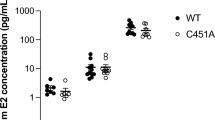Abstract
OESTROGEN responsive cells contain a specific proteinaceous macromolecule—one receptor—capable of recognising physiologically active oestrogens as well as a number of synthetic oestrogen agonists and antagonists1,2. In the nonstimulated state, the majority of receptors are located in the cytoplasmic fraction of responsive cells3,4, including the chick oviduct5. When oestrogen reaches the target cell, it binds to the cytoplasmic receptor causing its ‘activation’ and the translocation of the hormone–receptor complex to the nucleus. The interaction of receptor with chromatin is thought to facilitate gene transcription and the synthesis of proteins implicated in the changes characteristic of the oestrogenic response6,7. Receptor is retained in the nucleus for varying periods of time depending on the concentration and nature of the oestrogen. In the rat uterus, the length of time that receptor is retained in the nucleus correlates well with a number of parameters of the hormonal response8. The initial translocation of receptor to the nucleus is followed by a period of cytoplasmic receptor replenishment3–5,9. This process is very important as it has been implicated in the ability of cells to respond to subsequent oestrogenic stimulation10,11. Anti-oestrogens prevent oestrogens from expressing their full effects on oestrogen target tissues. Recent studies have indicated that some non-steroidal anti-oestrogens (CI-628, nafoxidine and clomiphene) bind to cytoplasmic oestrogen receptor, induce the translocation of the antagonist–receptor complex to the nucleus, but fail to stimulate subsequent cytoplasmic receptor replenishment12–14. Oestrogen antagonism would be primarily due to inhibition of cytoplasmic receptor replenishment12. Further, such a hypothesis could explain the weak oestrogenic activity of these compounds following a single injection when cytoplasmic receptor is translocated to the nucleus, and their subsequent potent anti-oestrogenic activity after serial injections when the low cytoplasmic receptor level is the limiting factor in receptor translocation15. We present here results which illustrate that this theory of anti-oestrogenic action does not hold for tamoxifen (ICI 46,474) in the chicken oviduct.
This is a preview of subscription content, access via your institution
Access options
Subscribe to this journal
Receive 51 print issues and online access
$199.00 per year
only $3.90 per issue
Buy this article
- Purchase on Springer Link
- Instant access to full article PDF
Prices may be subject to local taxes which are calculated during checkout
Similar content being viewed by others
References
Baulieu, E. E. et al., Vitams Harm. 33, 649–736 (1975).
King, R. J. B. & Mainwaring, W. I. P. (eds) Steroid-Cell Interactions (Butterworth, London, 1974).
Jensen, E. V. et al. Proc. natn. Acad. Sci. U.S.A. 59, 632–638 (1968).
Gorski, J., Toft, D. O., Shyamala, G., Smith, D. & Notides, A. Rec. Progr. Hormone Res. 24, 45–80 (1968).
Sutherland, R. L. & Baulieu, E. E. Eur. J. Biochem. 70, 531–541 (1976).
O'Malley, B. W. & Means, A. R. Science 183, 610–620 (1974).
Schimke, R. T., McKnight, G. S., Shapiro, D. J., Sullivan, D. & Palacios, R. Rec. Progr. Hormone Res. 31, 175–211 (1975).
Clark, J. H., Anderson, J. N. & Peck, E. J., Jr, in Receptors for Reproductive Hormones 36 (eds O'Malley, B. W. & Means, A. R.) 15–59 (Plenum, New York, 1973).
Mester, J. & Baulieu, E. E. Biochem. J. 146, 617–623 (1975).
Anderson, J. N., Peck, E. J., Jr, & Clark, J. H. Endocrinology 95, 174–178 (1974).
Katzenellenbogen, B. S. Endocrinology 96, 289–297 (1975).
Clark, J. H., Peck, E. J. Jr, & Anderson, J. N. Nature 251, 446–448 (1974).
Capony, F. & Rochefort, H. Molec. cell. Endocr. 3, 233–251 (1975).
Katzenellenbogen, B. S. & Ferguson, E. R. Endocrinology 97, 1–12 (1975).
Clark, J. et al. Hormone and Antihormone Action at the Target Cell (eds Clark, J., Klee, W., Levitzki, A., and Wolff, J.) pp. 147–169 (Dahlem Konferenzen, Berlin, 1976).
Oka, T. & Schimke, R. T. J. Cell Biol. 43, 123–137 (1969).
Toft, D. O. & O'Malley, B. W. Endocrinology 90, 1041–1045 (1972).
Mester, J. & Baulieu, E. E. Eur. J. Biochem. 72, 405–414 (1977).
Palmiter, R. D., Moore, P. B. & Mulvihill, E. R. Cell 8, 557–572 (1976).
Clark, J. H. & Peck, E. J. Jr, Nature 260, 635–637 (1976).
Lebeau, M. C., Massol, N. & Baulieu, E. E. Eur. J. Biochem. 36, 294–300 (1973).
Harper, M. J. K. & Walpole, A. L. J. Reprod. Fert. 42, 251–258 (1967).
Lee, A. E. J. Endocr. 60, 167–174 (1974).
Author information
Authors and Affiliations
Rights and permissions
About this article
Cite this article
SUTHERLAND, R., MEŠTER, J. & BAULIEU, EE. Tamoxifen is a potent ‘pure’ anti-oestrogen in chick oviduct. Nature 267, 434–435 (1977). https://doi.org/10.1038/267434a0
Received:
Accepted:
Issue Date:
DOI: https://doi.org/10.1038/267434a0
This article is cited by
-
Inhibition of environmental estrogen-induced proliferation of human breast carcinoma MCF-7 cells by flavonoids
In Vitro Cellular & Developmental Biology - Animal (2001)
-
Gonadal steroid modulation of neuroendocrine transduction: A transynaptic view
Cellular and Molecular Neurobiology (1996)
-
Effect of anordiol on ovarian hormone secretion, ovulation, and uterine and vaginal responses in the immature rat
Advances in Contraception (1994)
Comments
By submitting a comment you agree to abide by our Terms and Community Guidelines. If you find something abusive or that does not comply with our terms or guidelines please flag it as inappropriate.



